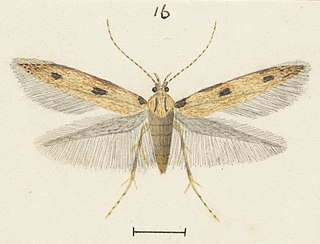Microcolona is a genus of moths of the family Elachistidae described by Edward Meyrick in 1897.

Labdia anarithma is a moth of the family Cosmopterigidae. It was described by Edward Meyrick in 1888. It is found in New Zealand and through out Australia. Adults are on the wing from December to March and are day flying. They have been collected by sweeping bracken fern.
Microcolona cricota is a moth in the family Elachistidae. It is found in southern India and Assam.

Microcolona limodes is a species of moth in the family Elachistidae. It is endemic to New Zealand. The larvae of this moth eat the seeds of endemic Myrsine species.
Microcolona technographa is a moth in the family Elachistidae. It is found in north-eastern India.
Microcolona transennata is a moth in the family Elachistidae. It is found in Brazil (Para) and Peru.
Microcolona arizela is a moth in the family Elachistidae. It was described by Edward Meyrick in 1897. It is found in Australia, where it has been recorded from New South Wales and Tasmania.
Microcolona characta is a moth in the family Elachistidae. It was described by Edward Meyrick in 1897. It is found in New Zealand and Australia, where it has been recorded from New South Wales.
Microcolona crypsicasis is a moth in the family Elachistidae. It was described by Edward Meyrick in 1897. It is found in Australia, where it has been recorded from New South Wales and Tasmania.
Microcolona embolopis is a moth in the family Elachistidae. It was described by Edward Meyrick in 1897. It is found in Australia, where it has been recorded from Queensland.
Microcolona epixutha is a moth in the family Elachistidae. It was described by Edward Meyrick in 1897. It is found in Australia, where it has been recorded from New South Wales.
Microcolona leptopis is a moth in the family Elachistidae. It was described by Edward Meyrick in 1897. It is found in Australia, where it has been recorded from Western Australia.
Microcolona leucochtha is a moth in the family Elachistidae. It was described by Edward Meyrick in 1897. It is found in Australia, where it has been recorded from New South Wales and South Australia.
Microcolona ponophora is a moth in the family Elachistidae. It was described by Edward Meyrick in 1897. It is found in Australia, where it has been recorded from New South Wales.
Microcolona sollennis is a moth in the family Elachistidae. It was described by Edward Meyrick in 1897. It is found in Australia, where it has been recorded from New South Wales.
Microcolona thymopis is a moth in the family Elachistidae. It was described by Edward Meyrick in 1897. It is found in Australia, where it has been recorded from New South Wales.
Microcolona trigonospila is a moth in the family Elachistidae. It was described by Edward Meyrick in 1897. It is found in Australia, where it has been recorded from New South Wales and Victoria.
Gnathifera aphronesa is a moth in the family Epermeniidae. It was described by Edward Meyrick in 1897. It is found in Australia, where it has been recorded from Tasmania.
Gnathifera opsias is a moth in the family Epermeniidae. It was described by Edward Meyrick in 1897. It is found in Australia, where it has been recorded from Tasmania.
Thiotricha pancratiastis is a moth of the family Gelechiidae. It was described by Edward Meyrick in 1921. It is found in Japan and Assam, India.

